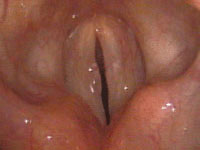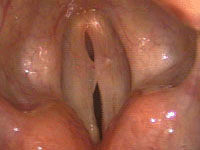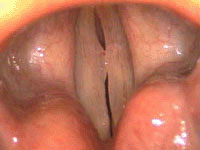Medical
No medications were recommended.
Behavioral modification is the initial treatment of these mucosal lesions and is likely a lifelong treatment for this patient. It is seldom someone can change their personality but it is possible for someone to manage their behavior. She is a severely impaired singer, yet it is usually not the singing that is the problem. More often it is the amount of talking that goes on daily. She rates herself a 7 and 6 on the talkativeness and loudness scales.
Many times managing their talkativeness will reduce a vocal fold swelling to an acceptable size such that the voice becomes dependable and acceptable to the patient, though the capillary ectasia on the vibratory margin makes this a difficult managment problem since that will likely swell with moderate usage or rupture intermittantly.
Speech therapy can be very helpful in controlling the amount and style of vocal use.
Physician treatment information
After behavioral management surgery would be indicated if the patient desires further improvement. Surgery is directed at removing only the mucosal lesion and preserving as much of the intermediate and deep layers of the vocal fold as possible.
With an appropriately delicate touch, this polyp can be removed most successfully. Patients experience a substantial improvement. In fact, in singers, who may have had the swellings for many years, they may feel the improvement is greater than 100%, suggesting that they had been dealing with vocal fold swellings even longer than they imagined.
Laser, cautery or stripping of the vessel on the vocal fold margin may be successfully used to remove this ectasia.
|


